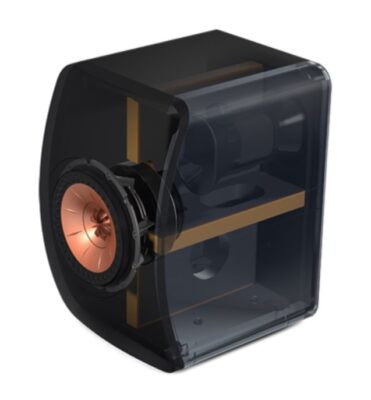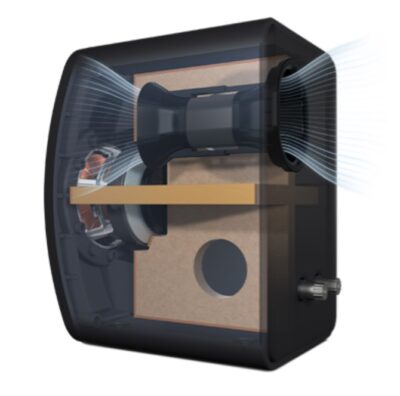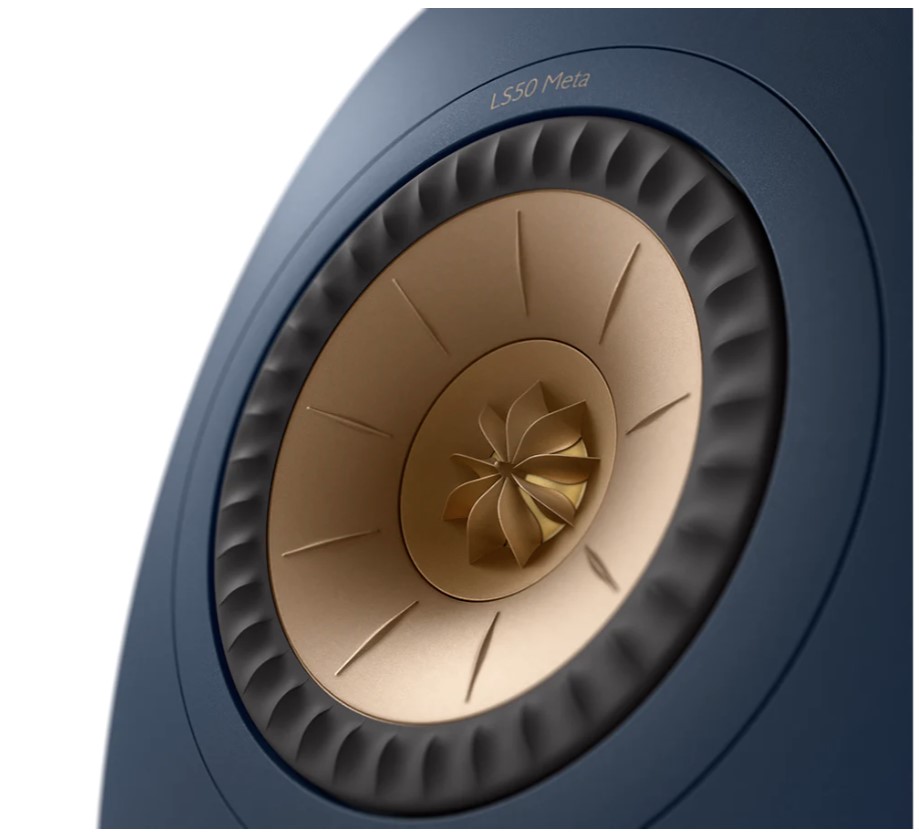There have been many reviews of this modern high-tech loudspeaker, so the purpose today is to add another data point of opinion about this popular speaker. The observations below focus on reference level comparisons, not considering the speaker’s price against similarly priced competition. The $1,599 LS50 Meta is available in four colors: Carbon Black, Titanium Grey, Mineral White and Royal Blue Special Edition. Inside the small curved enclosure are a few notable features.
The enclosure material is KEF’s proprietary “Metamaterial”, a synthetic of ABS. The Meta utilizes a 12th generation Uni-Q driver with the tweeter positioned at the center of the mid-woofer. A unique sound deadener, called Metamaterial Absorption Technology, is installed behind the woofer and “absorbs 99% of the unwanted sound from the rear of the driver”. This is a 39% improvement over the earlier, non-Meta version. The front baffle is formed from an injection molding material called Dough Moulding Compound. The rear port has a flexible section that is configured “to delay the onset of turbulence” and “prevent resonances from couloring the midrange”. THD is reduced by 30%.

The frequency response is listed as 47Hz-45kHz -6dB, and 79Hz-28kHz -3dB., with sensitivity of 85dB SPL. A 20 Watt amplifier wasn’t powerful enough to let these speakers really sing, and a subwoofer definitely helped give these small speakers more of a full range character. The 5.25-inch mid-woofer has a magnesium/aluminum cone, and the 1-inch tweeter utilizes an aluminum alloy dome with KEF’s Tangerine Waveguide. Please use the link below to visit the KEF Website, where you can find a white paper describing these and other features in detail.
The LS50 Metas were installed on 21” stands that usually support B&W 805 D4 or Alta Audio Celesta FRM-2M speakers. The B&W has a sensitivity rating of 88dB SPL versus the KEFs at 85dB SLP. It seemed that the volume control was turned up more than was needed to compensate for that 3dB difference.

Upon first listen, this audiophile was disappointed in the harshness of the upper frequencies and poor bass definition. Bass definition and detail is largely delivered by frequencies in the upper bass, which the specs suggest should be good. In a small room or large closet, the KEF’s bass is just sufficient. I don’t require very low, pants-fluttering seismic bass, but adding a small sub is definitely recommended.

After several hours of loud playing, the upper frequencies improved greatly and opened the door to much more enjoyable listening. The Metas exhibited good tone which is dependent on good resolution. The continuity between the mid-woofer and tweeter is excellent, clearly showing the care of the engineering team to deliver a good sounding product. The resolution of the larger driver and the tweeter seems very similar, helping to make the crossover disappear sonically.
The mid-upper treble, which is the home of “air”, sparkle, some harmonics, and other high frequency sounds and effects, is receded, taking some crispness and detail with it. Some sounds, such as wind and the ringing of a cymbal, can sound more like white noise than nature or a musical instrument. The midrange has very good articulation and control. Voices maintain their character and show humanness, while a virtual connection to the performers usually seemed just out of reach. The Alta Audio Celestas, with their ribbon tweeters, are far more resolving and purer in the treble. The Elac Vela speakers, with their Heil Air Motion-type “Jet 6” tweeters, also surpass the KEF’s treble quality and apparent extension.
 A strength of the little KEFs is the sound stage that they can create. My notes show the words “sound stage” crossed out and replaced with “Soundscape” to describe a very large and well-defined sonic image. Instrument placement is excellent, although performers seem to blend into adjacent or nearby performers around the edges. Sound stage height is fairly limited, so high stands are recommended.
A strength of the little KEFs is the sound stage that they can create. My notes show the words “sound stage” crossed out and replaced with “Soundscape” to describe a very large and well-defined sonic image. Instrument placement is excellent, although performers seem to blend into adjacent or nearby performers around the edges. Sound stage height is fairly limited, so high stands are recommended.
I borrowed the Audience Clairaudient The ONE v4 from the office system. These are small, single driver speakers with a 3-inch driver and a rear-firing passive radiator. The Audience speakers are usually placed on my computer table, just a few inches from the wall behind them. With this placement, bass output is adequate, but on the same stands used for the KEFs, the LS50 Metas have deeper and more dynamic bass, and can maintain their sound quality to higher SPLs than the even smaller The ONE. At lower levels, such as near-field listening to background music, The ONEs have a small advantage in upper treble resolution even without a dedicated tweeter.
The KEF LS50 Meta is a good performer, often delivering enjoyable listening. They are extremely well made-looking, with a finish that survives mild handling. All speakers, including those costing 4 or 5 figures, have some “character”. It is up to you to discover if the personality of the LS50 Meta is compatible with your listening preferences.
Overall Rating: 8 LPs
Link to manufacturer: KEF

